Nikon 1 J1 and V1 Review
Nikon 1 J1 and V1
The Nikon 1 system marks Nikon's entry into the compact system camera market. We go hands-on with the J1 and V1 to see how it measures up.
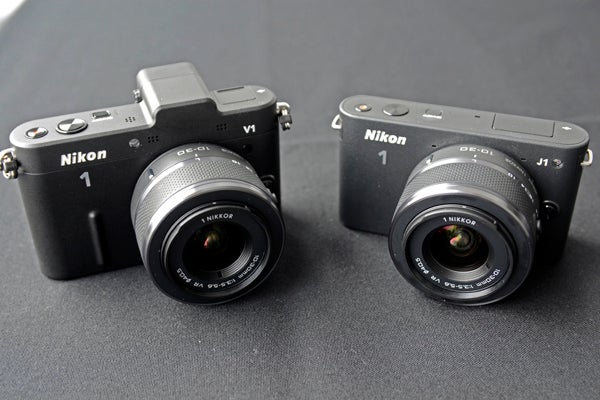
Verdict
Pros
- Small, stylish, well designed
- Lenses are super small
- Expeed 3 image processer is super-fast
Cons
- Questions remain over CX sensor image quality
Key Specifications
- Review Price: £549.99
- Nikon CX-format sensor (13.2 x 8.8mm)
- ISO 100-3200 (expandable to ISO 6400)
- 1080p Full HD movie recording at 30fps
- All-new dual-core Expeed 3 image processor
- Super fast contrast/phase-detect AF performance
Nikon has finally made its long-anticipated entrance into the interchangeable lens compact system camera market with the launch of the Nikon 1 system, and the V1 and J1 cameras pictured below are the first models to grace the range. Nikon gave us some extended hands-on time
with both of the new Nikon 1 models along with the full set of dedicated
lenses that have been designed specifically for use with the new CX-
format mount (Nikon’s first new mount since the F-mount in
1959, no less).
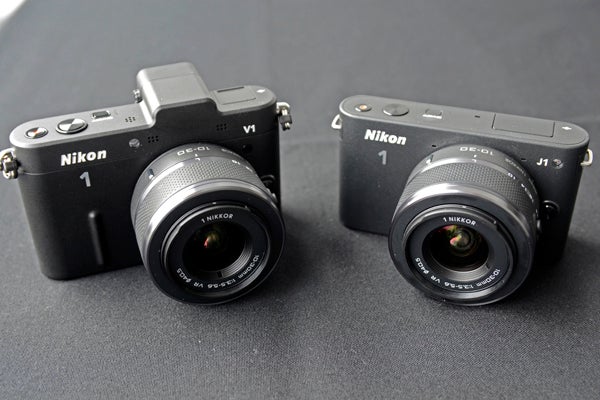
Given that the samples on show were pre-production models without final firmware Nikon was understandably reluctant to let anyone take any images with them, although they did at least load some of the test samples with memory cards so that we could get a better feel for them.
We’re not going to re-list all of the technical specifications in
any great detail here, as these details are easy to find elsewhere –
either in our original news article or on Nikon’s own microsite.
We are, however, happy to share our initial thoughts on what the new
cameras and lenses, indeed the new system as a whole, brings to the
table and what we’ll be especially keen to look at in more detail as and
when we get some review samples in for a full test.
First impressions for both of the new Nikon 1 bodies are, we have to
say, very positive; picking them up for the first time, both cameras
feel extremely stylish and well made. Both models share the same
unfussy, uncluttered approach, allowing the clean lines and simple form
factor of each to shine through.
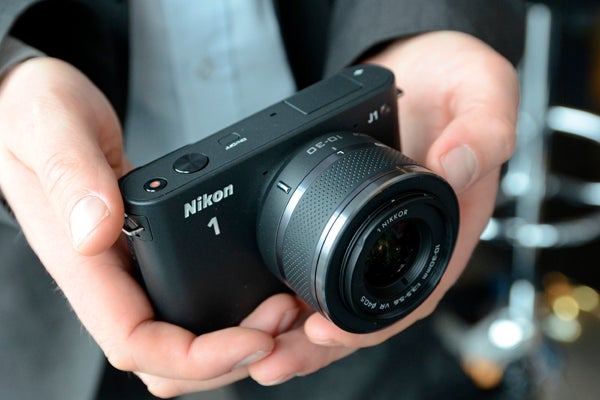
Size-wise, the J1 is especially
small, smaller than the Sony NEX-C3 even. The V1 is a bit bigger and
chunkier, primarily due to the Electronic ViewFinder (EVF) that juts out of the top. There’s no
finger grip at all on the J1 and the V1 gets little more than a raised
bar. Neither model gets a thumb rest either. Despite these omissions,
both cameras sit quite well in the hand and give easy access to the
various controls and buttons.
Looking specifically at what’s inside the cameras, without doubt the key talking point is the physical dimensions of Nikon’s all-new CX sensor that underpins the Nikon 1 system. Measuring 13.2 x 8.8mm, the CX sensor is larger than the 5.7 x 4.2mm compact-sized (1/1.2in) sensor used by the Pentax Q system, but smaller than the 17.3 x 14mm Micro Four Thirds chip and considerably smaller than 23.6 x 15.8mm APS-C sensors.
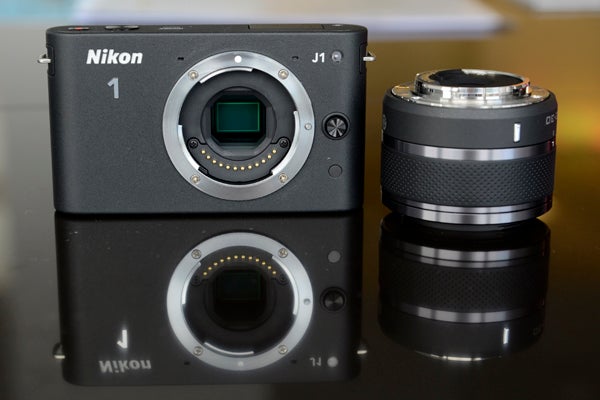
The big question that many are asking right now is where exactly does the new Nikon CX-format sit within the hierarchy of the compact system camera market? Given that the CX sensor is closer in size to the Pentax Q than it is to the APS-C sensors used by the Sony NEX and Samsung NX range, some observers are already tempted to write Nikon’s CX format off as somehow inferior, before even giving it a proper go. We’d rather have a look at what the cameras can do ourselves, and then make our own judgements about image quality. And certainly to write CX off at this stage simply because the sensor isn’t as big as APS-C strikes us as a bit simplistic.
In the case of both the J1 and V1, the decision to peg resolution at 10.1-megapixels seems like a sensible decision to us. Not only should it increase the potential for better low-light/high-ISO performance, but also the smaller file sizes generated by a 10MP sensor (compared to say, a 16.2MP one) will make them easier to share – especially for casual photographers who don’t want to have to re-size their images for email and web use. Nikon clearly doesn’t intend either camera to be for professionals to shoot billboard-sized posters with, so there’s really no need to overpopulate the sensor,
especially if it interferes with other aspects of image quality.
One
thing we certainly will be keen to look at in more detail once we get review samples in, is how the
smaller sensor affects depth of field. Inherently, smaller
sensors can’t create the extremely shallow depth of field that
larger sensors can, and which is so beloved of enthusiast photographers. Can the V1 or J1 create the desirable ‘bokeh’ effect when
paired with a f/2.8 lens and used wide open? We very much look forward to
finding out.
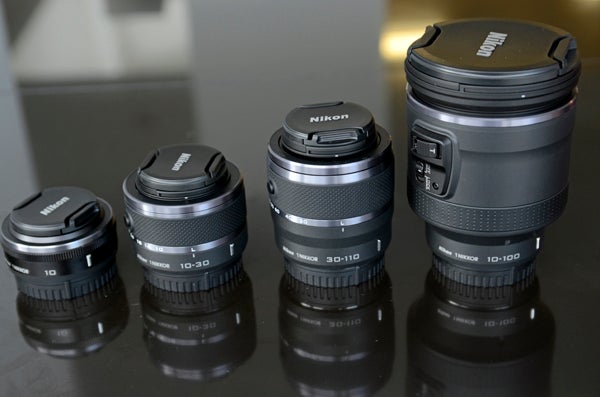
While the J1 and V1 both look interesting, the dedicated Nikon 1 lenses were perhaps the real stars of the big CX reveal. From the 10-30mm f/3.5-5.6
kit zoom to the 10mm f/2.8 pancake lens and the 10-100mm f/4.5-5.6
video-specific lens, the new lenses perfectly compliment the new bodies,
creating a very stylish and, above all, portable overall package.
Using
a retractable design and sporting internal Vibration Reduction
technology, they look to be smaller and more compact than comparable
offerings from Sony, Samsung, Panasonic or Olympus. Even the 30-110mm
f3.8-5.6 telephoto zoom just about folds down enough to fit inside a
(large) jacket pocket – quite some feat when you consider it offers the
equivalent of 70-297mm in 35mm terms.
Of course, we’d need to
have a proper look at each individual lens to see how well they perform
in terms of image quality, but for now they appear to win hands-down in
the miniaturisation stakes. Only the Pentax Q system is likely to offer
an interchangeable lens system with smaller lenses.
One recurring theme that we heard a lot from Nikon, and which formed a large part of their presentation, was speed. Using the all-new dual-core Expeed 3 image processor, Nikon even claim their new Nikon 1 models are the “world’s fastest cameras”. The new system also offers an AF system that, interestingly, uses a combination of 135-point contrast-detection and 73-point phase-detection to deliver super-fast autofocus. In addition, Nikon claims that the data-crunching power of the new Expeed 3 is able to deliver up to 60fps continuous shooting at full resolution. If that does indeed turn out to be the case, we’ll be very impressed indeed.
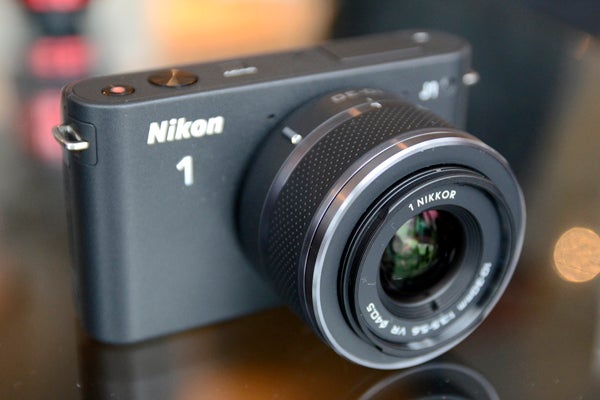
The other big theme of the launch that Nikon was keen to hammer home was how Nikon 1 started from a clean slate and has been built from the ground up to work as a perfectly-honed system. To this end Nikon had brought along quite a large collection of accessories that can be used with the two cameras. There’s no standard hotshoe on either camera, although the V1 does sport a proprietary accessory port that can be used to attach a number of dedicated accessories such as a new Speedlight flash or the Nikon ME-1 microphone. There’s even a ringflash and a large video monitor available. Nikon has clearly brought the Nikon 1 system to the table ready to roll, which is to be commended.
Turning our attention, briefly, to the shooting modes, as expected both of the Nikon 1 models get the full range of semi- and full-automatic shooting modes (PASM) even though they are a little buried in the menu system rather than immediately selectable from the shooting dial. These are complimented by an Automatic Scene Selector mode and two all-new modes – Motion Snapshot and Smart Photo Selector. The first of these combines a single still image with one second’s worth of slow-motion movie footage to offer what Nikon describe as a ‘living image’. It certainly sounds like a interesting idea, although we’ll have to wait and see how large the resultant files are. Smart Photo Selector, meanwhile, takes 20 shots with a single shutter press before selecting and presenting the user with the best five images. In this respect it could be a useful tool for point-and-shoot enthusiasts looking for blink-free, smile-heavy portraits with minimum fuss.
Movie-wise, both of the new models offer the ability to record movies at a maximum setting of 1080p Full HD at 30fps. Like most of the compact system camera fraternity, we do like how the new supercharged processor makes it possible to record still images at full resolution while simultaneously recording movies – that’s definitely a bonus and will undoubtedly lead to fewer of those agonised on-the-spot ‘video or stills?’ decisions and more spontaneous shooting of both mediums. The V1 also sports an external microphone port, whereas the J1 doesn’t.
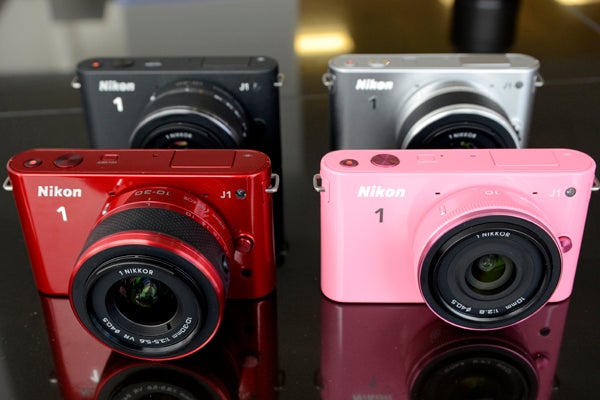
So, who exactly is likely to be buying either of these two new models? Well, Nikon’s decision to offer the J1 in a choice of five colours – Black, Silver, Red, White and Pink – probably reveals more about who the J1 is targeted at than any of the headline specifications do. Basically, and as Nikon themselves were only too happy to admit during the presentation, the J1 is very much aimed at the mass market. During the Q&A session at the end of the presentation Nikon even talked of taking a “market-leading position” with the new camera. While the V1 is the camera that will appeal to enthusiasts, the J1 appears to be the camera Nikon hopes will be the big seller.
Of course a large determining factor here, is the price. On this we can’t help but feel that Nikon may have come in a bit high. Of course, launch prices can often fall quite quickly, depending on demand (or a lack of) and discounting competition between retailers. In this respect we wouldn’t be wholly surprised to see the quoted launch prices of £549 for the J1 and £829 for the V1 fall closer to £450 and £750 before Christmas. The problem the V1 in particular will face, is that it’s £829 price tag put’s it in direct competition with the best compact system cameras like the Olympus EP-3, and some heavyweight SLRs as well. The highly rated Panasonic Lumix G3, by comparison, now seems pretty cheap. It’ll be interesting to see how Nikon fares against its established compact system rivals.
Verdict
We’re quite excited by the new Nikon 1 system. The J1 and V1 camera bodies are nicely designed, handle well and look fantastic, while the accompanying lenses push the concept of miniaturisation to a new level. Yes, the smaller dimensions of the CX sensor does throw up some questions, but these will be answered one way or another in due course. For now though, there’s a brand new interchangeable-lens CSC system on the block from a major manufacturer, and in the long-run that can only be good for the advancement of digital camera technology.

